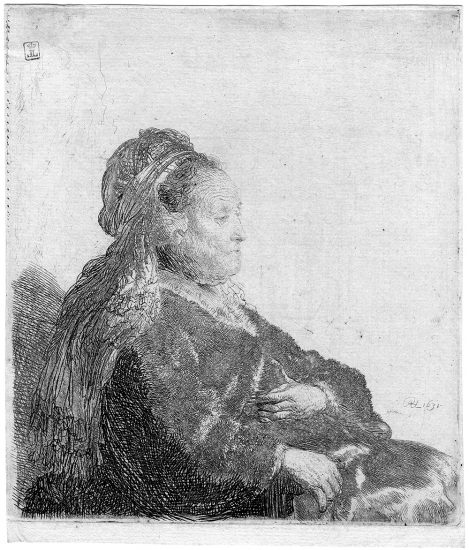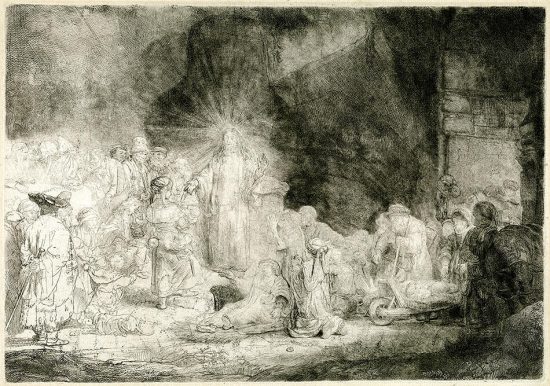Why do we feel collecting lifetime impressions are important?
Several other art dealers and auction houses will inform the buyer of only the state designation for the print (seemingly comparing the state to a badge of authenticity). The critical information is whether the print was produced during the artist's lifetime. A later state impression may exhibit NONE of artist's original work, by the artist’s hand; the subtlety, quality, detail, or characteristics that a lifetime impression would possess are lost. I know I am out of sync with many dealers and auction houses on this, but I will explain further why I feel state discrepancies are important to address in Old Masters.
Please note: The study of old master prints is very complex and connoisseurs can spend a lifetime becoming an expert on just one artist. I seek to continually advance my own scholarship of such areas, becoming knowledgeable in all aspects of printmaking and Old Master prints.
Why is Masterworks Fine Art, Inc. concerned about lifetime impressions?
Lifetime impressions (also known as contemporary printings or impressions) are prints that were produced during the artist’s lifetime. This is in contrast to prints produced after the artist died (e.g. re-strikes).
What is so important about lifetime impressions?
An etching plate, for example, lasts maybe 100-150 impressions before it needs to be re-worked or re-etched (leading to secondary or tertiary states or more). Otherwise, the impression from that plate becomes grey because the lines do not hold ink as the plate has been worn from the printing process. As a plate gets re-etched by the printmaker over time, there is less and less of the artist's hand present.
An etching is made by scratching a sharp object into a copper surface, or plate. When the line is scratched in, it produces raised elements of copper “shavings” that are displaced by the scraping of the line into the plate. This is known as burr. If burr is present, it means the print was made from an early impression of that state of the plate, further implying the artist’s involvement in the creation of the print.
In the case of Rembrandt van Rijn (1606 – 1669) for example, by the time of Jean, a collector of Rembrandt’s etching plates in the early 19th century, there is, in general, little of Rembrandt's hand left in the etching…. I personally feel that these works are not very collectible.
What is a state?
The proofs taken while the artist is working on the plate, stone, etc. to check different stages of his progress are known as states; each one showing additional working constitutes a different state. The last one is said to be the definitive state (or proof). [Ref. Melot, M. et. al. (1981) History of an Art: PRINTS, Editions d’Art Albert Skira S.A.: Geneva]
Aren't all impressions after the 1st state considered late impressions?
I believe this presumption to be incorrect, especially when making global assessments of Rembrandt’s works. Many of the artist’s etchings are found in many states - up to 10 or more. Comparatively, some prints are only found in one state. Rembrandt, and presumably several other printmakers and artists, may have worked and re-worked his plates over time; each time a plate was re-worked, it would create a new state. The expertise used to distinguish these various states has been the subject of many argumentative books and discussions.
Do catalogues of Rembrandt’s works necessarily correspond with one another for etching and state designations?
No, these designations / assessments vary from catalogue to catalogue of Rembrandt’s etchings, depending on the author or scholar. The following list of catalogues are included in the library at Masterworks Fine Art, Inc:
1) Nowell-Usticke, G.W., Rembrandt’s Etchings, 1967 or 1988 re-print.
2) Biörklund, George, Rembrandt’s Etchings: True and False, 1968
3) White, Christopher and Boon, Karel, Rembrandt’s Etchings, Vol. 1 & 2, 1969
4) Hind, Arthur, A Catalogue of Rembrandt’s Etchings, 1967
Some go by Nowell-Usticke's system, some Hind, some Biörklund, and some Bartsch. Occasionally these catalogues correspond, however there are also some discrepancies. I consider Nowell-Usticke's catalogue as a good basis to start referencing Rembrandt’s works, but I then compare the other catalogues (especially Biörklund) for more detailed information.
What should I collect?
It is my opinion, that the only collectible Rembrandt prints are those that were produced during Rembrandt’s lifetime, between 1606 and 1669; presumably these were created by his own hand. Almost all of the Rembrandt etchings available at Masterworks Fine Art, Inc. are considered to be lifetime impressions, although we have some later editions available (in general, they will be from a 17th century or very early 18th century edition).
Heard about Rembrandt editions being pulled every hundred years?
More than 85 original plates survived Rembrandt’s death (some of these have been deemed copies or student work). These plates have become the reference from which later editions have been made. The concept of producing editions every 100 years is silly. I find Rembrandt prints editioned within the last 100 years are simply not collectible. These late impressions bear little, if any, of Rembrandt's original work because these plates have been re-worked to allow new editions to be made.





